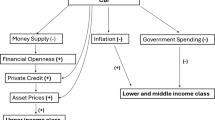Abstract—
One simple economic model, frequently cited but difficult to empirically calculate, is the Laffer curve: the relationship between the level of taxation and tax revenues. The increase in the VAT rate in Russia from 18 to 20% since 2019 can be considered as an empirical test of the existence of patterns in the Laffer curve at a particular point in time. From the Laffer curve it follows that with an increase in the tax rate, revenue should increase at a slower rate. In contrast, the volume of VAT payments in 2019 increased at a faster pace than the growth in value added. The paper proposes an explanation of this contradiction in terms of the impact of efforts to ensure tax collection. Increase in the basic tax rate by 2% pp led to a reduction in the return on efforts to ensure the collection of the tax. A five-year period of fast outpacing tax revenue growth came to an end almost simultaneously with the increase in the VAT rate. We can conclude that the economy, even with a relatively small increase in the tax rate, predictably reduces the ability of the state to extract additional income.
Similar content being viewed by others
REFERENCES
J. Wanniski, “Taxes, revenues, and the Laffer curve,” Publ. Interest 50, 3–14 (1978).
W. J. M. Heijman and J. A. C. van Ophem, “Willingness to pay tax: the Laffer curve revisited for 12 OECD countries,” J. Soc. Econ. 34 (5), 714–723 (2005). https://doi.org/10.1016/j.socec.2005.07.013
A. Badel and M. Huggett, “the sufficient statistic approach: predicting the top of the Laffer curve,” J. Monet. Econ. 87, (2017). https://doi.org/10.1016/j.jmoneco.2017.02.001
G. Gomeh and M. Strawczynski, “Simulating corporate tax rate at Laffer Curve’s peak using microdata,” J. Econ. Bus. 112, (2020). https://doi.org/10.1016/j.jeconbus.2020.105930
S. N. Alpysbaeva, M. K. Kenzhebulat, and G. Zh. Karashulakov, “Potential for an increase in the tax burden at the reduction of the zone of fiscal contradictions (based on the materials of the economy of Kazakhstan),” Ekon. Zh. Vysh. Shk. Ekon. 23 (3), 365–383 (2019).
N. Makasheva, “Macroeconomic reconciliation? (About the book by Yu. Ananiashvili and V. Papava. Laffer-Keynesian synthesis and macroeconomic equilibrium),” Vopr. Ekon., No. 3, 151–159 (2015).
E. Balatskii, “Effectiveness of the state’s fiscal policy,” Probl. Prognozirovaniya, No. 5, 32–45 (2000).
V. Papava, “Laffer effect with aftereffect,” Mir. Ekon. Mezhdunarod. Otnosh., No. 7, 34–39 (2001).
E. Balatskii, “Invariance of fiscal Laffer points,” Mir. Ekon. Mezhdunarod. Otnosh., No. 6, 62–71 (2003).
E. Balatskii and N. Ekimova, “Fiscal policy and economic growth,” O-vo Ekon., No. 4, 197–214 (2011).
Yu. Ananiashvili and V. Papava, “Laffer-Keynesian synthesis and macroeconomic equilibrium,” O-vo Ekon, No. 9, 98–119 (2010).
M. Kakaulina, “Impact of the tax burden on economic growth in the Russian Federation: a regional aspect,” Nalogi Nalogooblozh., No. 17(344), 55–64 (2014).
K. Isakov and S. Pekarskii, “Assessment of the impact of financial repression on budget revenues,” Ekon. Polit. 11 (5), 28–49 (2016). https://doi.org/10.18288/1994-5124-2016-5-02
E. V. Balatsky and N. A. Ekimova, “Evaluation of Russian economic sectors' sensitivity to tax burden,” J. Tax Reform, No. 6 (2), 157–179 (2020). https://doi.org/10.15826/jtr.2020.6.2.080
A. Ivanova, M. Keen, and A. Klemm, “The Russian 'flat tax' reform,” Econ. Policy 20 (43), 397, 399–444 (2005).
Y. Gorodnichenko, J. Martinez-Vazquez, and Peter K. Sabirianova, “Myth and reality of flat tax reform: micro estimates of tax evasion response and welfare effects in Russia,” J. Polit. Econ., No. 117 (3), 504–554 (2009). https://doi.org/10.1086/599760
F. G. de Oliveira and L. Costa, “The VAT Laffer curve and the business cycle in the EU27: an empirical approach,” Econ. Iss. 20 (2), 29–44 (2015).
F. Pappadá and Y. Zylberberg, “Austerity and tax compliance,” Eur. Econ. Rev. 100, 506–524 (2017). https://doi.org/10.1016/j.euroecorev.2017.09.007
M. Waseem, “Taxes, informality and income shifting: evidence from a recent Pakistani tax reform,” J. Publ. Econ. 157, 41–77 (2018).
G. Kurovskii, Assessment of the contribution of the VAT increase to annual inflation. Analytic note, Bank of Russia, December 2019. http://www.cbr.ru/content/document/file/94684/analytic_note_20191217_ ddcp_01.pdf. Cited May 25, 2021.
Author information
Authors and Affiliations
Corresponding author
Rights and permissions
About this article
Cite this article
Kalinin, A.M. Increasing the VAT Rate in Russia from the Position of the Laffer Curve. Stud. Russ. Econ. Dev. 33, 353–358 (2022). https://doi.org/10.1134/S1075700722030042
Received:
Revised:
Accepted:
Published:
Issue Date:
DOI: https://doi.org/10.1134/S1075700722030042




